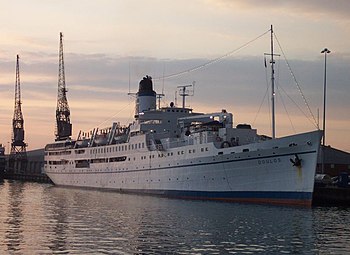MV Doulos

The Doulos at Southampton, England in 2004.
|
|
| History | |
|---|---|
|
|
|
| Name: | SS Medina |
| Operator: |
Mallory Steamship Company (1914–1932) Clyde-Mallory Line (1932–1948) |
| Ordered: | 28 August 1913 |
| Builder: | Newport News Shipbuilding and Dry Dock Company |
| Yard number: | 176 |
| Laid down: | 21 January 1914 |
| Launched: | 22 August 1914 |
| Sponsored by: | Frances Stuart Semmes |
| Christened: | 22 August 1914 |
| Acquired: | 29 September 1914 |
| Commissioned: | 29 September 1914 |
| Fate: | Transferred to Cia Naviera San Miguel SA, 1948 |
| History | |
|
|
|
| Name: | SS Roma |
| Operator: | Cia Naviera San Miguel SA |
| Acquired: | 1948 |
| Fate: | Transferred to Costa Lines, 1953 |
| History | |
|
|
|
| Name: | MS Franca C |
| Operator: | Costa Lines |
| Port of registry: |
Genoa, |
| Acquired: | 1953 |
| Fate: | Transferred to Gute Bücher für Alle, 1977 |
| History | |
|
|
|
| Name: | MV Doulos |
| Operator: | Gute Bücher für Alle |
| Port of registry: |
Valletta, |
| Acquired: | 1977 |
| Identification: | |
| Fate: | Transferred to BizNaz Resources International Pte Ltd, 2010 |
| Notes: | Her name means "Servant" in Greek. |
| History | |
|
|
|
| Name: | MV Doulos Phos |
| Operator: | BizNaz Resources International Pte Ltd |
| Port of registry: |
Valletta, |
| Acquired: | 2010 |
| Fate: | Hotel Ship |
| Notes: | Her name means "Servant Light" in Greek. |
| General characteristics (as built) | |
| Tonnage: | 5,426 GRT |
| Length: | 410 feet |
| Beam: | 54 feet |
| Height: | 54 feet |
| Draught: | 18.2 feet |
| Installed power: |
Single triple-expansion engine, 4 coal-fired boilers, 4,100 hp shaft power (Converted to oil 1922) |
| Speed: | 14 knots |
| General characteristics (1949 onwards) | |
| Tonnage: | |
| Propulsion: |
|
| Speed: | 15 knots |
| Capacity: | 414 |
| Crew: | 350 |
Mallory Steamship Company (1914–1932)
Single triple-expansion engine, 4 coal-fired boilers, 4,100 hp shaft power
The ship currently known as the MV Doulos Phos held the record of being the world's oldest active ocean-faring passenger ship until December 2009, having plied the world's oceans from the time of her building in 1914 until being retired from cruising service at the end of 2009. She is now owned by Mr. Eric Saw, director and chief executive of BizNaz Resources International Pte Ltd in Singapore. She was previously owned by the German charity Gute Bücher für Alle (Good Books for All), and was used as a floating bookshop. The ship has previously been known as the SS Medina, the SS Roma, the MS Franca C, and the MV Doulos. The Doulos ended her final cruise in late 2009 at Singapore, with the ship being handed over to her new owners on 18 March 2010. As of late 2016 she was undergoing conversion into a luxury hotel with an anticipated opening in December 2016.
On 28 August 1913, a contract for two steel freight steamships was signed by Newport News Shipbuilding and Dry Dock Company and the Mallory Steamship Company of the United States. "The vessel will be a single screw steamship of the hurricane deck type with straight stem and elliptical stern, and with deck houses amidship and aft for the crew accommodations...." The original specifications referred to the vessels as hulls No. 175 and No. 176. Hull No. 175 would eventually be named SS Neches and hull No. 176 became SS "Medina". (Neches would be lost in a collision with British warship in 1918.) The full contract for the vessels filled a 186-page volume and included the fittings commonly used in a ship for her era and also provision for tropical itineraries – mosquito nets for the crew quarters. The keel for hull No. 176 was laid on 21 January 1914 and officially became the SS Medina when she was christened just a few months later on 22 August 1914. Her sponsor was 15-year-old Frances Stuart Semmes, daughter of the then-mayor of Newport News.
Medina was in a high stage of completion when launched, for she was delivered just five weeks later on 29 September 1914. Total elapsed time, from keel laying until delivery, was less than nine months. One reason for the rapidity of construction was due to the normal work week at the shipyard, which in those days was 50 hours a week (in 1913, the regular work week was six, ten-hour days, but that proved impractical because of limited daylight hours during the wintertime.)
...
Wikipedia
